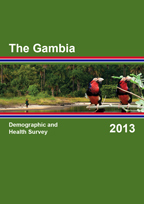Spotlight on Implementing Agencies: The Gambia

(L-R) Gambian visitors Saikou Trawally, Alieu Saho, Momodou L. Cham & DHS Program staff member Zhuzhi Moore at The DHS Program Headquarters in Rockville, MD
Name(s): Saikou Trawally, Alieu Saho, and Momodou L. Cham
Country of origin: The Gambia
Position titles and organizations: Officials of The Gambia Bureau of Statistics and National Population Commission Secretariat
When not working, favorite place to visit: Shopping sites, relatives and friends, and site seeing cultural centers.
First time you worked with The DHS Program’s data:
Momodou: I first used the Data in 2001 for my MSC. Medical Demography Dissertation at the London School of Hygiene and Tropical Diseases, University of London.
What has been the nicest surprise visiting The DHS Program headquarters?
The infrastructure, expertise of staff, the wonderful reception, and the knowledge sharing.
What do you miss most about home when you are here? Family
What is the biggest difference between The DHS Program headquarters office and your office at home?
Reliable communication facilities, furniture, the office space and environment.
What is your favorite DHS final report cover? 2013 The Gambia DHS cover with a green background with flora and fauna in the middle of the page.
Favorite DHS chapter or indicator, and why?
Mortality (infant, child, and maternal mortality) and HIV/AIDS. This is the first time we are getting accurate data on these indicators. The data will help The Gambia know the level of progress towards addressing such issues.
What population or health issue are you most passionate about? Why?
Reproductive health is important because the health of the mother determines the health of the newborn.
How do you hope the DHS data from your country will be used?
The data should be used for planning, monitoring, and informing national policies on health and population.
What have you learned from the DHS experience?
We have learned a lot about survey design, sampling, data collection and processing, analysis, and producing a standard technical report that is internationally comparable.


